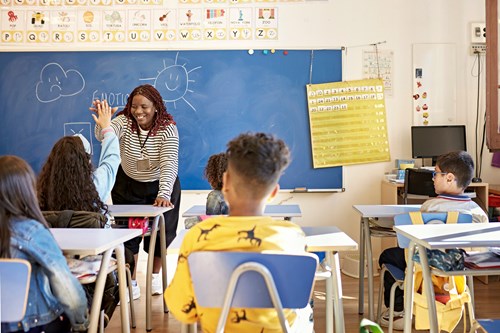Paper-light teaching: the way forward
Paper-light, or materials-light teaching, not only helps teacher do their bit for the environment, it can also lead to more student involvement, wise use of technology and creative use of images and realia in the classroom.
With the world experiencing the highest summer temperatures on record in many places, I’m sure we are all incentivised to do our bit for the environment. Besides including topics like climate change and recycling into your lessons, have you ever thought about how much paper you are using? With many face-to-face summer schools in full swing, this seems to perfect time to consider paper-light teaching. If you are not entirely sure what I’m talking about, then read on to learn more!

Copies, copies and more copies
As a teacher educator working regularly with learner-teachers I often think back to my own start in English language teaching (ELT). When I first started teaching adults in New Zealand, I used to arrive at school way before the other teachers. Don’t get me wrong, I still like coming in early to get my mind in the right frame for teaching, have a cuppa and have a chat with my colleagues, but in the past, I used to come in to give myself enough time to allow time to fight the photocopier because I desperately needed those copies! Does that sound familiar?
We had a set of well-known course books for class and a teacher’s room filled with a variety of supplementary resources. And looking back now, I can only say that I used to copy a decent – some might call it an excessive – amount of ‘extras’ as an early-career teacher of English. So, every day I’d enter the classroom with not only a detailed lesson plan but also a pile of photocopies linked to the topic or specific language areas the course book covered that week.
Questions for reflection:
- How many sheets of paper (on average) you use in your lessons each day?
- How many of these bits of paper do you really need? If you haven’t thought about this before, this might be the right time and while you are at it, think about your ‘why’.
Why oh, why?
Looking back, it seems crazy that the pile of photocopies was once so important to me that it was worth waking up earlier to get to school just to beat the copier queue! And I wasn’t the only one doing so it seemed! As an experienced teacher reflecting on this past habit, I really wonder what made me feel that I needed to bring all these extra handouts into the classroom that badly. Because, as you can probably predict, most of those ‘extra’ activities were not used at all and ended up in the paper recycling bin at the end of the week!
So, think about:
- How do you feel about going to class without a pile of copies?
- What challenges might paper-light bring?

It’s all about confidence
So why do I think that pile of photocopies meant the world to me then? Well, when we start teaching there are so many things to think of, so I wonder if my pile of photocopies served as a kind of safety blanket (otherwise known as a security blanket) showing that I cared about students’ learning and that I had prepared their lessons thoroughly.
In addition, stakeholders, such as parents or caregivers, might expect to see homework sheets and learners themselves might expect to physically take something away from the lesson. And don’t forget about our own expectations. Teachers often teach the way they were taught, so maybe we were used to being handed out tasks for homework. In other words, having those copies means we meet common expectations which might as a result makes us feel more secure.
And being an early career teacher, although even experienced teachers still experience this when starting with a new group, it can be hard to guess how long activities really take. Timings provided in teacher books are approximate and how long a task or activity really takes depends on our learners’ level, interest and familiarity with the kind of task or activity. So having those activities at hand means we can manage the extra time if needs be and feel prepared for the unexpected, which makes total sense!
Then, there might be the fear that learners might not get into the topic, or activities provided on their coursebook. When learners lack a deep level of engagement, they might be more focused on getting a task done, than doing it well. Please tell me that I’m not the only one that has had learners shout ‘Teacher, finished!’ after three minutes while I was convinced that the task would generate a lot more interest and outcome.

How to move towards paper-light teaching?
Now, let me just clarify that I’m not talking about paper-free or resource-light teaching, such as approaches like Dogme encourages. Even though many teachers might enjoy that challenge and regard it as the pinnacle of responsive, learner-driven teaching, often teachers have no choice but to follow a certain coursebook provided by management.
For me, it was a quote by Earl Stevick I read many years ago that got me thinking: ‘Success depends less on materials, techniques, and linguistic analyses, and more on what goes on inside and between people in the classroom’ (1980:4).
This quote inspired me to challenge myself to plan for at least one paper-light lesson a month, yes you read that right one a month. I started small which meant it was manageable and over time my confidence as a teacher has grown and by now, I'm quite happy to walk into the classroom with one image, video or one speaking task. But how did I get started?
- I asked colleagues for their favourite paper-light activities – those that involved a board, the students’ notebooks and maybe some images.
- Observing experienced teachers, I took notes of activities that did not involve a lot of photocopies, such as board games, dictations and creative discussion tasks.
- Looking at reading and listening texts, I realised there were many ways to mine the text for lexis, grammar, personalised speaking and follow-up writing tasks.
- Once I felt confident in teaching a certain language area or skill, I found I had more mental space to respond to students ‘emerging needs and interests. So, I started noting down their errors and questions during activities and took the time to respond to these in the feedback stage.
- When digital tools became the norm, I started to experiment with using technology to reduce photocopied handouts – Padlet is still one of my favourite tools to upload a task for all learners to read and respond to.

Some practical tips
To round this post off, here are a few pointers that you might want to experiment with:
1. Using learners as a resource
Instead of copying, consider if you can get learners to note take. For instance, dictate statements about a video or text and get learners to write these into a True/False/Not given table they draw in their notebook. Or simply, get them to bring in an item, such as a gift that means a lot to them, or images to talk about.
2. Use realia and images as a creative prompts
Find a rich image about a person or animal in your coursebook or online. Put learners into pairs or 3s. Get learners to think about three questions they would like to ask the person or animal in the image. They write their three questions in their partner’s notebook. The learners then take their own notebook back and write a short paragraph including answers to the three questions.
3. Using technology as an alternative
There is a plethora of excellent apps and websites out there that can be used instead of handouts. Padlet, as I mentioned earlier, is a user-friendly and versatile resource. Wooclap and Mentimeter are also great online tools for brainstorming and predicting. However, if you really need a handout and your learners have internet access, think about uploading it on a Padlet or check out Gyazo.
Final thoughts
I hope this blog will encourage you to reflect on your relationship with the photocopier and give you some ideas to challenge yourself to go paper light. Why not create a Padlet for all teachers in your school where they can share their favourite paper-light activities? Even better, why not challenge teachers in your community to commit to one paper-light day a month? Sounds like an excellent start to me!
Do let us know how you get on in the comments or via Pavilion ELT’s social media.
References
Dobbs, B. (2018). ‘Paper-free and resource-light business communication training’. Modern English Teacher, 27: 1. Shoreham-by-Sea: Pavilion publishing and Media.
Stevick, E. W. (1980). Teaching Languages: A Way and Ways (Teacher Development Series), 4. Harlow: Longman ELT.

Comments
Write a Comment
Comment Submitted